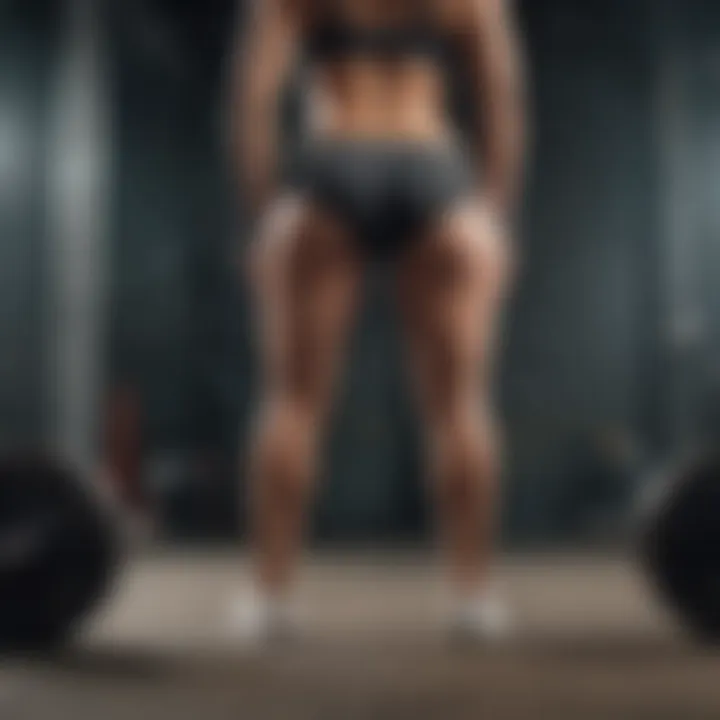Exercises to Tone Your Butt: A Comprehensive Guide


Intro
The pursuit of a toned buttocks is not only a matter of aesthetics but also encompasses benefits to physical health and functional fitness. Understanding the significance of gluteal strength is crucial for anyone interested in enhancing their overall fitness. Strong glute muscles support proper posture, improve athletic performance, and may even help prevent injuries.
This article will delve into various exercises targeting the glutes, dissecting their execution, the specific muscle groups activated, and strategies to optimize results while minimizing injury risk. Additionally, it will touch on the role of a holistic fitness regimen that includes adequate nutrition and recovery, providing a well-rounded approach to achieving your goals.
Wellness
Physical Health
Engaging in exercises that strengthen the gluteal muscles offers myriad health benefits. The glutes are responsible for movement patterns and stability. Exercises like squats, lunges, and deadlifts not only tone these muscles but also improve strength in the lower body overall.
Furthermore, improving glute strength can enhance your metabolic rate. Muscle tissue burns more calories than fat, even at rest.
Mental Health
Exercise is well-documented for its positive effects on mental health. When you work on toning your butt, you engage in physical activity that may lead to feelings of empowerment and accomplishment. Completing a challenging workout can stimulate the release of endorphins, which may help in reducing anxiety and depression.
Nutrition and Diet
Nutrition plays a pivotal role in supporting any exercise regime. Consuming adequate protein aids in muscle repair and growth. Foods like chicken, lentils, and Greek yogurt can be beneficial. Pairing protein intake with healthy fats and complex carbohydrates will provide sustained energy for workouts.
- Proteins: Chicken, fish, beans, lentils
- Healthy Fats: Avocados, nuts, olive oil
- Complex Carbs: Quinoa, sweet potatoes, whole grains
Fitness and Exercise
Incorporating a variety of exercises is essential for comprehensive glute training. Here are some effective exercises:
- Squats: Targets the entire lower body and glutes.
- Lunges: Works on balance and stability.
- Deadlifts: Engages multiple muscle groups, focusing on glute strengthening.
- Glute Bridges: Specifically isolates and builds the glute muscles.
Each of these exercises has specific techniques to maximize effectiveness. Proper execution is key to avoiding injuries and ensuring that the right muscles are being engaged during a workout.
"Strengthening your glutes can significantly improve your quality of life, both physically and mentally."
As you work towards your fitness goals, remember that consistency and patience are paramount. This journey is about improving oneself comprehensively, not just in appearance but in overall wellness.
Understanding Glute Anatomy
Understanding the anatomy of the gluteal muscles is fundamental in targeting and toning them effectively. This knowledge goes beyond mere aesthetic appeal; it helps in enhancing overall functional fitness, reducing the risk of injury, and improving performance in various physical activities. The glutes consist of three primary muscles: the gluteus maximus, gluteus medius, and gluteus minimus. Each plays a distinctive role in body movement and stability, contributing to both athletic performance and daily tasks such as standing, walking, and climbing.
Knowing their structure allows individuals to tailor their workouts to emphasize specific muscle groups, leading to more effective results. Furthermore, by appreciating the functional importance of the glutes, individuals can become more mindful during their workouts, ensuring they implement correct form and technique to maximize engagement of these crucial muscles.
Gluteus Maximus
The gluteus maximus is the largest and most powerful muscle in the gluteal group. It primarily contributes to movements that bring the thighs back and support the body's upright posture. This muscle is essential for activities like squatting, running, and stepping, and it plays a central role in creating a well-defined rear. Strengthening the gluteus maximus can lead to improvements in strength and power, making it particularly significant for athletes involved in sports that demand explosive movements.
Gluteus Medius
The gluteus medius lies on the outer surface of the pelvis and is smaller than the gluteus maximus yet equally important. This muscle's primary function is to stabilize the hip and pelvis while walking or running. It helps abduct the leg, moving it away from the body. A strong gluteus medius can help prevent common injuries, especially in the knees and lower back. It also contributes to a balanced physique, aiding in improved aesthetics as well as functionality.
Gluteus Minimus
The gluteus minimus is the smallest of the three gluteal muscles and sits beneath the gluteus medius. Like the medius, it assists in hip stabilization and abduction. This muscle also helps with the internal rotation of the thigh. Although smaller, the gluteus minimus's role is crucial for maintaining balance and mobility, especially when the body is in motion.
Functional Importance of the Glutes
The glutes are not merely aesthetic muscles; they serve vital functions in athletic performance and daily living. They influence various bodily movements, including:
- Stability: Strong glutes provide a solid base for many exercises and movements, preventing injuries.
- Posture: They play an essential role in maintaining correct posture by supporting the spine during activities.
- Power Generation: The glutes are key players in movements requiring strength and power, such as sprinting or jumping.
- Injury Prevention: By ensuring proper alignment and support, strong glutes help avert injuries in the knees, lower back, and hips.
In summary, understanding the anatomy of the glutes is crucial for anyone looking to tone their butt effectively. It lays the foundation for focusing on specific exercises that promote strength, enhance performance, and improve aesthetics.
The Benefits of Toning Your Glutes
Toning your glutes yields several benefits, significant for both aesthetics and functional fitness. Engaging in targeted glute workouts not only enhances your physical appearance but also contributes to overall body strength and posture. Understanding these benefits can motivate individuals to incorporate glute exercises into their regular routine.
Aesthetic Enhancements
One primary reason many focus on toning their glutes is the aesthetic improvement it offers. Well-defined glute muscles can change the silhouette of the body, providing a curvier and more balanced appearance. This can increase self-confidence and body image satisfaction. As you build muscle through consistent training, the buttocks appear firmer and higher. This improvement can influence how clothes fit, leading to a more attractive appearance overall. Toned glutes also complement other physical activities, making additional workouts and movements more efficient.
Improved Posture
Toned glutes play an important role in improving posture. The gluteal muscles support the pelvis and lower spine. When these muscles are strong, they contribute to a neutral spine alignment. Poor posture can lead to a myriad of health issues, including back pain and discomfort. Working on glute strength, through various exercises, can counteract slouching and promote a more upright stance. Survivors of prolonged sitting or sedentary lifestyles especially benefit from improved posture, which can translate to long-term health advantages.
Enhanced Athletic Performance
Strengthening the glutes can significantly enhance athletic performance. The gluteal muscles are critical for many physical activities, including running, jumping, and cycling. These muscles act as primary movers when generating power in your lower body. For athletes, targeting the glutes can lead to improved speed and agility. Improved glute strength supports explosive movements and increases overall endurance during competitions. As a result, athletes may see improved performance metrics owing to their focused training.
Injury Prevention
Injury prevention is another vital aspect of toning your glutes. Weak glute muscles can lead to compensatory movement patterns, creating undue stress on muscles and joints, which may result in injuries. Strong glutes help stabilize the hips and lower back, reducing the risk of strains and other injuries during physical activities. Additionally, maintaining balanced muscle development through glute training may alleviate issues related to muscle imbalances. Adopting a routine that emphasizes glute strengthening can promote long-term physical health and mobility.
It is essential to remember that strong glutes contribute to not only aesthetics but also functional health.


By acknowledging the multifaceted benefits of glute toning, individuals can better appreciate its role within a comprehensive fitness regimen. These factors collectively motivate consistent engagement in targeted glute exercises, leading to improved overall well-being.
Essential Equipment for Effective Workouts
Having the right equipment is crucial for achieving successful glute workouts. Using effective tools can enhance the effectiveness of your exercises, allowing for targeted muscle engagement, improving overall performance, and facilitating progressive overload. Investing in quality equipment also means that workouts can be adapted to different fitness levels and goals, keeping routines fresh and engaging.
Free Weights
Free weights like dumbbells and kettlebells play a vital role in glute training. They force the body to stabilize itself, which engages additional muscle groups. When performing exercises such as squats or lunges with weights, there is a greater recruitment of gluteal muscles compared to using only bodyweight. The added resistance helps in muscle hypertrophy, which leads to increased strength and better definition over time.
Incorporating free weights requires careful attention to form. Proper technique ensures that stress is directed towards the glutes instead of joints. Beginners should start with lighter weights, gradually increasing as they build confidence and strength.
Resistance Bands
Resistance bands are versatile and portable, making them an excellent addition to any workout routine. They provide variable resistance throughout the movement, which can enhance the muscle activation in the glutes significantly. Bands can be used during a range of exercises like glute bridges and lateral walks.
The benefit of resistance bands lies in the constant tension they provide. This tension keeps the glute muscles engaged throughout the exercise, leading to more effective workouts. They can also be used to warm up the muscles before heavier lifting, reducing the risk of injury. Additionally, they are inexpensive and accessible, making them suitable for all fitness levels and settings.
Exercise Balls
Exercise balls, or stability balls, are great for glute workouts due to their ability to create an unstable surface. This instability forces the body to engage core muscles along with the glutes for stabilization. Exercises like ball squats or leg curls enhance the effectiveness of glute training while also working on balance and coordination.
Using exercise balls also adds a layer of functionality to workouts, promoting proper body alignment during movements. For those interested in improving athletic performance, exercise balls can be particularly beneficial in enhancing overall body control and stability.
Bodyweight Exercises
Bodyweight exercises are fundamental in building a strong glute foundation. They require no equipment and can be performed anywhere, making them an excellent choice for individuals who prefer to work out at home or do not have access to a gym. Effective bodyweight exercises include squats, lunges, and glute bridges.
One significant advantage of bodyweight exercises is the ability to focus solely on form, which is essential for injury prevention. As strength increases, individuals can modify the exercises by incorporating variations to make them more challenging. Bodyweight workouts can also serve as an excellent warm-up before using weights or resistance bands.
Using the right equipment in your workouts opens the door to better results and reduces the risk of injuries.
Effective Exercises for Toning Your Butt
Toning the glutes involves specific exercises that target these muscles effectively. This section discusses various exercises essential for building strength and improving appearance. Each exercise mentioned offers unique benefits, helping individuals to achieve their fitness goals efficiently. By focusing on the glutes, one can enhance functional fitness while also improving aesthetics. With proper technique, these exercises can lead to significant advancements in both strength and tone.
Squats
Classic Squats
Classic squats are a fundamental exercise for anyone looking to tone their butt. This exercise primarily targets the gluteus maximus, making it a leading choice in any workout regime. Classic squats are effective because they engage multiple muscle groups, including the quadriceps and hamstrings. Their key characteristic is simplicity and versatility, as they can be performed anywhere without equipment. A unique feature of classic squats is their ability to improve lower body strength and stability. However, it's crucial to maintain proper form to prevent knee injuries.
Sumo Squats
Sumo squats introduce a variation that changes foot positioning to target different parts of the glutes. By widening the stance and turning the toes outward, sumo squats emphasize the inner thigh and glutes more than classic squats. This makes them a beneficial choice for individuals looking to sculpt the inner thigh while toning the buttocks. The unique feature is the position that recruits additional muscle fibers, enhancing muscle engagement. A disadvantage might be difficulty for beginners who may struggle with balance in this wider stance.
Jump Squats
Jump squats add a plyometric element to a classic squat, increasing the exercise's intensity. This explosive movement not only targets the glutes but also improves cardiovascular fitness. Their key characteristic is the dynamic nature that elevates heart rate quickly, making them a popular choice in high-intensity workouts. A distinctive feature of jump squats is their ability to promote muscle power and endurance. However, they can be challenging for those with joint issues, so caution is advised.
Lunges
Forward Lunges
Forward lunges are another effective exercise targeting the glutes. They involve stepping forward into a lunge position, primarily engaging the gluteus maximus and quadriceps. A key characteristic of forward lunges is their ability to help enhance balance and coordination. This exercise's unique feature is that it works each leg individually, promoting muscle symmetry. However, improper form may lead to knee strain, hence it's important to focus on technique.
Reverse Lunges
Reverse lunges are similar to forward lunges but executed by stepping backward. This shift of movement helps minimize stress on the knees. The key characteristic of reverse lunges is their increased activation of the glutes and hamstrings, making them an effective option for toning. The unique feature is providing better stability, as it is often easier to maintain balance during this motion. There are very few disadvantages aside from potential confusion when switching between reverse and forward lunges for beginners.
Side Lunges
Side lunges focus on the outer glutes and inner thighs. This lateral movement is essential for developing strength across the hips. The key characteristic of side lunges is the different angle compared to traditional lunges, which effectively targets various muscle groups. A unique feature is their ability to enhance hip flexibility. However, they may not be as familiar to some practitioners, which leads to slight discomfort during initial attempts if not properly demonstrated.
Deadlifts
Traditional Deadlifts
Traditional deadlifts are a compound exercise that targets the entire posterior chain, with a significant focus on the glutes. Their key characteristic is the lifting motion, which engages multiple muscle groups and promotes overall strength. The unique aspect of deadlifts is their effectiveness at improving posture and reducing back weakness. However, they require strict form to prevent injury, which can be difficult for beginners to master.
Single-Leg Deadlifts
Single-leg deadlifts are a variation that emphasizes stability and balance. This version engages the glutes intensely while requiring core stabilization. The key characteristic is the unilateral focus, which builds strength evenly across both glutes. Its unique feature lies in the functional benefits it provides, such as improved coordination and balance. Yet, beginners may struggle with form and balance, increasing the risk of injury if performed incorrectly.
Romanian Deadlifts
Romanian deadlifts target the glutes by emphasizing the eccentric movement. This variation allows for a greater stretch in the hamstrings and glutes. Its key characteristic is the hip hinge movement, focusing on glute activation. The unique feature is that it does not require weights to be lifted from the ground, which reduces the risk of injury. However, improper technique can lead to back strain, so awareness of form is essential.
Hip Thrusts
Hip thrusts isolate the glutes effectively, making them a popular choice for toning. The exercise focuses on lifting the hips with the back supported, targeting the gluteus maximus extensively. They are particularly beneficial for individuals seeking to enhance their buttocks' appearance. A major advantage is the focused engagement of the glutes, which allows for maximum muscle activation without straining other muscle groups. However, some may find difficulty adjusting to the correct position, which is critical for effectiveness.
Glute Bridges


Glute bridges are similar to hip thrusts but typically executed without added weight. This exercise is valuable for beginners trying to engage the glutes. Its key characteristic is that it emphasizes proper hip movement and glute activation. Unique features include the ease of performing this movement anywhere without equipment. Nonetheless, those looking for higher intensity may find the exercise less challenging as they build strength.
Step-Ups
Step-ups are functional exercises that incorporate balance and strength training. By stepping onto a raised platform, step-ups primarily target the glutes and quadriceps. The key characteristic of step-ups is that they mimic real-life movements, enhancing overall functional fitness. One unique aspect is the versatility of using various heights to adjust intensity. A disadvantage could be the added strain on the knees, especially with improper technique.
Fire Hydrants
Fire hydrants target the outer glutes and hip muscles. This exercise is performed on all fours, lifting one leg outward. The key characteristic is its focus on the stabilizing muscles of the hips, which can lead to improved strength in that area. The unique feature is that fire hydrants can be performed with resistance bands for increased effectiveness. A downside is that mastering the technique may require practice for some to prevent strain on the lower back.
Creating a Structured Workout Plan
Creating a structured workout plan is fundamental for anyone serious about toning their glutes. Without a plan, workouts can lack focus and direction, resulting in ineffective routines. A well-crafted plan aligns workouts with individual goals and ensures that exercises are performed consistently and properly. This section will delve into critical elements of a structured workout plan, including frequency of training, incorporating variety, balancing with cardio, and setting realistic goals.
Determining Frequency
Frequency is a key consideration when establishing any workout plan. For glute toning, it is generally recommended to train the glutes at least two to three times per week. This frequency allows for sufficient stimulus to promote muscle growth while also providing time for recovery. Eliciting muscle engagement requires thoughtful planning about how often to perform specific exercises. Overtraining can lead to fatigue or injury, while infrequent workouts may yield minimal results.
One effective approach might include:
- Compound Exercises: Incorporate compound movements like squats and deadlifts.
- Isolation Work: Add in specific glute-focused exercises such as glute bridges and fire hydrants.
- Employee Rest Days: Allow for recovery, typically a day between major lower-body workouts.
Incorporating Variety
Adding variety to workouts prevents plateaus and keeps the training experience engaging. When the body encounters different movements, it adapts and grows stronger. A diversified workout plan could feature:
- Mixing different types of squats and lunges.
- Varying the intensity by changing the weight or resistance.
- Experimenting with different equipment such as resistance bands or exercise balls.
Encouraging various exercises stimulates all muscle fibers in the glutes, promoting comprehensive muscle development. It is useful to cycle through different exercises regularly, perhaps every four to six weeks, to maintain progress and motivation.
Balancing with Cardio
Integrating cardio activities complements strength training and promotes overall fitness. While toning the glutes is a primary goal, enhancing cardiovascular health is equally important. Cardio can:
- Aid in reducing excess body fat, allowing for better muscle visibility.
- Enhance recovery times between strength workouts.
- Provide variation to a predominantly strength-based routine.
Recommendations might include low-impact activities, such as cycling or swimming, as well as higher intensity workouts like HIIT, which can be beneficial without excessively taxing the muscles worked during glute training.
Setting Realistic Goals
Setting achievable goals provides clarity and direction for your workout plan. Define what progression looks like whether it is improving strength, endurance, or body composition. Goals should be
- Realistic: They must be attainable based on current fitness levels.
- Measurable: Use metrics such as weights lifted, repetitions completed, or time spent on exercises.
- Time-bound: Establish a timeline for achieving these goals.
A sample timeline might look like focusing on increasing squat weights by 5% every month. Initially, goal-setting should also consider individual constraints, such as time and workload, creating sustainable targets where success leads to more motivation.
"Consistency is key. A structured approach to training ensures you make gradual progress while minimizing risk of injury."
Creating a structured workout plan may seem daunting, yet it sets the stage for meaningful progress. Emphasizing frequency, incorporating variety, balancing with cardio, and setting realistic goals fosters an effective environment for glute toning. When approached thoughtfully, training can transform a routine into a powerful tool for lasting fitness.
Role of Nutrition in Muscle Toning
Good nutrition is a critical complement to a workout regimen aimed at toning the gluteal muscles. Many individuals often overlook how food choices directly impact muscle development and recovery. Proper nutrition supports muscle repair after rigorous exercise. It also enhances the body's ability to build and maintain lean muscle mass. This makes understanding the nutritional aspects key to achieving superior results.
Importance of Protein Intake
Protein plays a vital role in muscle recovery. Adequate protein intake after workouts helps repair muscle fibers damaged during exercise. Engaging the glute muscles, while performing exercises, requires a significant amount of protein to promote growth. The general recommendation is to consume around 1.2 to 2.0 grams of protein per kilogram of body weight, depending on activity levels. Sources such as chicken, fish, beans, and Greek yogurt are excellent for muscle repair.
Hydration Strategies
Hydration cannot be neglected when discussing nutrition for muscle toning. Staying well-hydrated helps optimize performance during workouts. Dehydration can lead to fatigue, which may limit one's ability to train effectively. It's advisable to drink water before, during, and after workouts. Electrolyte-rich drinks can also be beneficial after long or intense sessions, as they help maintain balance in body fluids and support muscle function.
Balanced Macronutrient Distribution
A balanced diet consisting of carbohydrates, proteins, and fats is essential for muscle toning. Carbohydrates are the primary energy source for workouts, while healthy fats support overall body functions. Ensuring a proper distribution can enhance the fueling of workouts and recovery. For effective muscle toning, consider aiming for 40% carbohydrates, 30% protein, and 30% fats. Foods like quinoa, avocados, nuts, and leafy greens fit well into this distribution.
Sample Meal Plans
Crafting meal plans can streamline your nutrition. Here is a sample outline:
- Breakfast:
- Snack:
- Lunch:
- Snack:
- Dinner:
- Scrambled eggs with spinach.
- A slice of whole grain toast.
- Fresh berries.
- Greek yogurt with honey.
- A handful of almonds.
- Grilled chicken breast.
- Quinoa salad with mixed veggies.
- Olive oil dressing.
- Carrot sticks and hummus.
- Baked salmon.
- Steamed broccoli.
- Brown rice.
Following this guide can assist in understanding the integration of nutrition with muscle toning efforts. Consistency in both diet and exercise will yield the best results in achieving toned glutes.


Injury Prevention and Recovery
Incorporating injury prevention and recovery strategies is crucial when engaging in exercises that target the gluteal muscles. Understanding the potential risks associated with butt exercises allows individuals to train more effectively and sustainably. Not only does this reduce the chance of injuries, but it also enhances the overall workout experience. Neglecting these aspects can lead to setbacks that may discourage continued commitment to fitness.
Warm-Up Techniques
Prior to performing intense exercises for the glutes, warming up should never be overlooked. Warm-up techniques increase blood flow to the muscles, raise body temperature, and improve overall flexibility, preparing the body for higher intensity activity.
Common warm-up exercises include:
- Dynamic stretches, such as leg swings and walking lunges.
- Foam rolling can also help release tension in the muscle fibers.
- Incorporating low-impact exercises like light jogging or brisk walking allows the body to ease into more strenuous workouts.
Setting aside just 10 to 15 minutes for warming up can reduce the chance of strains and sprains significantly.
Common Injuries in Glute Training
Many practitioners face similar injuries when working on glute exercises, often stemming from improper form, overexertion, or inadequate warm-ups. Common injuries include:
- Strains, particularly in the hamstrings or lower back.
- Tendinitis, which may affect the hip joint due to repetitive stress.
- Knee pain, arising from misplaced pressure during lunges or squats.
Awareness of these potential injuries can lead to better form and ultimately enhance the effectiveness of workouts.
Cooling Down After Workouts
Cooling down is as important as warming up. Post-exercise, the body needs time to transition back into a resting state. This phase helps in gradually lowering heart rate and minimizing muscle soreness. Typical cooling down activities include:
- Light activities, like slow walking for five to ten minutes.
- Gentle stretching, targeting the muscles worked during the session.
Incorporating a cool down can assist with quicker recovery and aid in reducing stiffness following an intense workout.
Stretching for Recovery
Stretching plays a vital role in muscle recovery post-exercise. It promotes blood circulation to fatigued muscles, facilitating faster recovery and aiding flexibility. For those focusing on glutes, specific stretches may include:
- Figure four stretch, which effectively targets the glutes.
- Hip flexor stretches, which counteract tightness often caused by glute workouts.
Regularly dedicating time to stretching can prevent tightness and maintain muscle elasticity.
To maximize the effectiveness of glute workouts, prioritize injury prevention alongside a solid recovery plan. It is not only about the exercises but how you prepare and recover that matters.
Tracking Progress and Making Adjustments
Tracking your progress in any fitness routine is essential for tangible success. In glute training, not only does it serve as a motivational tool, it also helps you understand how your body responds to different exercises. This knowledge allows you to make informed adjustments, ensuring your workout plan is effective and aligned with your goals.
Measuring Strength Gains
Monitoring strength gains is crucial to gauge whether your current workout regimen is effective. Use a simple system where you document the weights used and repetitions completed for various exercises. For instance, if you perform squats with 30 pounds and can increase this to 40 pounds over several weeks, it indicates progress. Such improvements suggest your glute muscles are adapting and growing stronger. Keep in mind that strength gains may sometimes plateau, and recognizing this is part of the process. Detailed records can help identify when changes are necessary.
Assessing Visual Changes
Visual changes may take time, but tracking them is equally important. Take regular photographs in consistent lighting and angles to visually assess progress. This method allows you to see gradual changes in muscle definition, which may not always reflect on the scale. Note that some individuals might gain muscle while losing fat, meaning the scale might not shift significantly. Instead, focus more on how your clothes fit or your overall body shape.
Adjusting Workout Intensity
Adjusting the intensity of your workouts is key to continued progress. If exercises feel too easy, it's time to increase the intensity. This could involve lifting heavier weights or increasing the resistance of bands. On the contrary, if you struggle to complete your set routine, you may need to decrease the weight or modify exercises. Striking that balance is vital. Keeping your muscles challenged ensures that the benefits of toning are maximized, while also preventing injury.
Implementing Feedback Loops
Establishing feedback loops can enhance your training effectiveness. After each workout, take a moment to reflect on what felt good and what didn't. Make adjustments based on this reflection. Did a particular exercise feel off? Perhaps you need a different variation or an increased focus on form. This ongoing process of reflection and adjustment is beneficial not just for physical gains, but mental commitment to your workout routine. > "Feedback is a powerful tool. Use it to refine your efforts toward achieving your goals."
In summary, tracking progress involves not only measuring gains and visual appearance but also adjusting workouts based on feedback and performance. Each element contributes to a more dynamic and responsive training approach, ultimately bringing you closer to your fitness goals.
Ending: A Commitment to Consistency
Consistency is the cornerstone in achieving any fitness goal, and toning your glutes is no exception. The exercises outlined in this guide require a steady approach to yield effective results. This section will explore the sustained effort needed for long-term success and the benefits that come from this commitment.
A structured routine that prioritizes glute workouts not only enhances muscle definition but also contributes to overall body strength. Regular engagement in exercises like squats, lunges, and hip thrusts builds muscle memory, allowing for improved performance and greater efficiency over time. Adhering to these workouts consistently leads to tangible progress in strength and aesthetics, promoting a stronger and more toned physique.
Long-Term Benefits of Glute Workouts
The advantages of committing to a consistent glute workout routine extend far beyond aesthetics. Some of the long-term benefits include:
- Increased Strength: Regularly working the glutes enhances overall lower body strength which is essential for physical activities, contributing to better performance in sports and daily tasks.
- Improved Stability: Strong glute muscles play a significant role in stabilizing the pelvis, thus reducing the risk of injury during physical activities.
- Enhanced Posture: Consistency in glute workouts contributes to better spinal alignment, aiding in improved posture.
Incorporating glute-focused exercises into your regular workout schedule can lead to remarkable improvements in both physical capability and appearance.
Cultivating a Positive Mindset
Attaining fitness goals, particularly when targeting muscle toning, requires more than just a physical commitment. Cultivating a positive mindset is crucial in keeping motivation high and overcoming challenges. By recognizing the incremental progress made over time, an individual can foster resilience against setbacks and maintain focus on their fitness journey.
Setting achievable goals, celebrating small victories, and maintaining a balanced perspective can bolster mental strength. A positive mindset not only aids in the enjoyment of workouts but also enhances the psychological benefits that come from regular exercise, such as reduced stress and increased self-esteem.
Final Thoughts on Progress
Progress is often slow and can sometimes be frustrating. However, it is crucial to realize that genuine improvement stems from the dedication and persistence put into workouts. Regular assessments of strength gains and visual changes will help in keeping track of improvement.
Remember to adjust workouts as needed and seek feedback, whether from a trainer or through self-evaluation, to keep enhancing the routine.
Ultimately, the commitment to consistency in glute workouts will serve to build not only stronger glutes but also a more positive relationship with fitness and health. Embrace the journey, stay committed, and observe how your body transforms over time.



